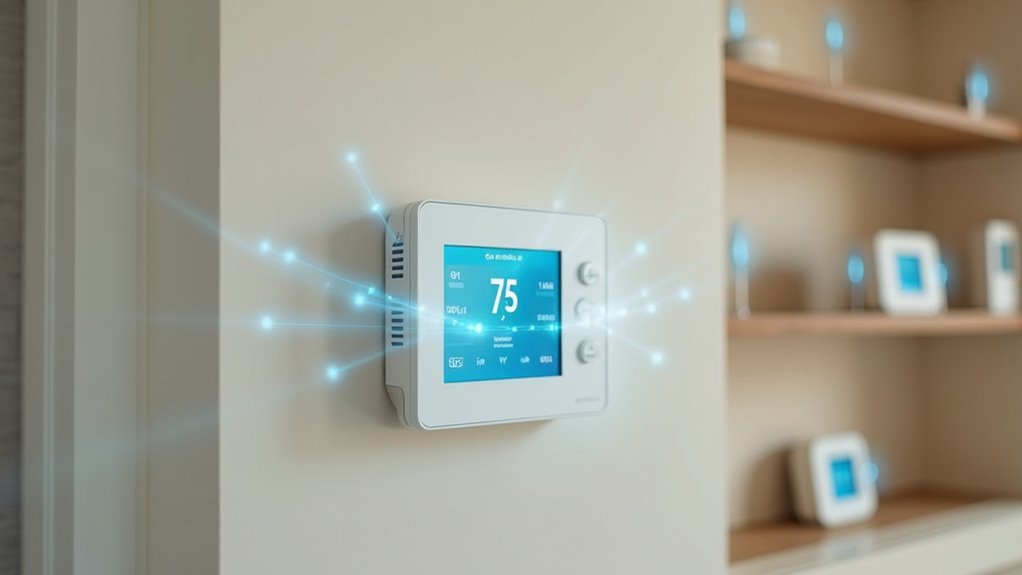You’ve invested in a mesh WiFi network to eliminate dead zones, but your smart thermostat keeps disconnecting or responding sluggishly. The problem isn’t your internet speed—it’s compatibility. Not all thermostats work seamlessly with mesh systems, and choosing the wrong model means dealing with frustrating connectivity issues that defeat the purpose of upgrading your home’s network infrastructure. The right thermostat can transform your experience entirely.
Understanding Mesh WiFi Compatibility Requirements for Smart Thermostats

While mesh WiFi networks offer seamless coverage throughout your home, they can create connectivity challenges for smart thermostats that weren’t designed with mesh topology in mind.
You’ll find that devices like the Ecobee Smart Thermostat Premium often experience frequent disconnections when connected to mesh systems. These connectivity issues stem from how mesh networks handle device roaming between access points and automatic channel optimization.
Your smart thermostat needs consistent, stable connections to function properly, but mesh networks can confuse devices during handoffs between nodes.
To overcome these challenges, you’ll want to contemplate locking your thermostat to a specific access point, disabling nightly channel optimization, or creating a dedicated IoT network.
Understanding these requirements helps you choose thermostats that’ll work reliably with your mesh network setup.
Ecobee Smart Thermostat Premium: Superior Mesh Network Performance
The Ecobee Smart Thermostat Premium stands out as a mesh network champion, delivering the stable connectivity that eluded earlier Ecobee models.
You’ll appreciate its built-in microphone and speaker that enable seamless voice control through Alexa, reducing your dependence on WiFi signal strength for basic commands.
The device’s AI learns your preferences, maximizing energy savings while maintaining reliable performance across various network conditions.
Smart AI technology adapts to your lifestyle, delivering optimal energy efficiency without compromising comfort across diverse network environments.
If you’re running Unifi mesh WiFi networks, you can enhance stability by locking the thermostat to specific access points, virtually eliminating disconnection issues.
Regular firmware updates have transformed the ecobee smart thermostat premium into a mesh-optimized powerhouse.
You’ll experience consistent connectivity that previous models couldn’t deliver, making this thermostat an excellent choice for modern mesh WiFi networks.
Google Nest Learning Thermostat 4th Gen: Advanced Connectivity Features

Google’s newest Learning Thermostat brings cutting-edge connectivity that rivals the Ecobee’s mesh network prowess.
You’ll find Wi-Fi connectivity seamlessly integrates with your home network, allowing remote control through the Nest app from anywhere. The Google Nest Learning Thermostat excels among smart thermostats with its advanced AI that learns your preferences and routines automatically.
You can easily adjust temperatures using the signature twist-and-push controls, while the included puck-style remote sensor guarantees consistent readings throughout your home.
The thermostat’s broad compatibility works with various HVAC systems, making installation straightforward regardless of your current setup.
This combination of intelligent learning algorithms and robust connectivity makes it an excellent choice for homes with mesh networks seeking ideal climate control.
Honeywell Home T9: Reliable Multi-Point Network Integration
Multiple remote sensors distinguish the Honeywell Home T9 as a powerhouse for mesh network environments, delivering consistent temperature monitoring across every room in your house.
This smart thermostat seamlessly integrates with multi-point WiFi networks, ensuring you’ll maintain stable connectivity regardless of your home’s layout.
The T9’s standout features for mesh network users include:
Key capabilities make the T9 ideal for modern mesh network setups and comprehensive smart home integration.
- Remote sensor technology that enables efficient multi-zone heating and cooling throughout your HVAC system
- Voice control compatibility with Alexa and Google Assistant for hands-free operation
- Mobile app control allowing you to schedule settings and optimize energy usage from anywhere
You’ll appreciate the straightforward installation process and broad HVAC system compatibility.
The Honeywell Home app puts complete thermostat control at your fingertips, making it simple to reduce energy consumption while maintaining comfort across your entire home.
Sensi Touch 2: Dual-Band WiFi for Enhanced Mesh Stability

You’ll appreciate how the Sensi Touch 2’s dual-band WiFi capability connects to both 2.4 GHz and 5 GHz networks, delivering rock-solid performance in mesh environments where other thermostats struggle.
This smart thermostat’s compatibility with multiple home automation platforms means you won’t face the connectivity headaches that plague many competitors.
The straightforward installation process takes advantage of your mesh network’s strengths while the intuitive setup walks you through optimizing both network bands for maximum stability.
Dual-Band Network Benefits
While most smart thermostats rely on single-band connectivity, the Sensi Touch 2 ST76 leverages dual-band Wi-Fi technology to deliver superior performance in mesh networks.
You’ll experience enhanced network stability through its ability to connect to both 2.4 GHz and 5 GHz frequencies, ensuring your smart home operates seamlessly.
The dual-band connectivity offers three key advantages:
- Reduced interference – Access to the less congested 5 GHz band minimizes signal conflicts with other devices
- Faster data rates – Higher frequency bands provide quicker response times for remote control commands
- Adaptive performance – Automatic band switching optimizes connectivity based on current network conditions
This intelligent dual-band approach means you won’t face the signal dropouts common with single-band devices, maintaining consistent thermostat control even in complex home networks.
Mesh Compatibility Features
Beyond its dual-band capabilities, the Sensi Touch 2 ST76 incorporates several mesh-specific features that maximize compatibility with modern distributed network systems.
You’ll benefit from its seamless integration across various smart home platforms, ensuring your thermostat works regardless of your preferred ecosystem. The device’s intelligent network selection automatically chooses the best band, preventing connectivity issues that plague single-band devices.
When multiple devices compete for bandwidth, you won’t experience the frustrating dropouts common with traditional thermostats. The ST76’s enhanced mesh stability stems from its ability to maintain consistent communication paths through your network’s nodes.
You’ll find this particularly valuable in larger homes where signal strength varies between rooms, ensuring reliable temperature control throughout your space.
Installation Setup Process
Installing the Sensi Touch 2 ST76 proves remarkably straightforward, with most homeowners completing the entire process in under 30 minutes without professional help.
The user-friendly installation process works seamlessly with various HVAC systems, while the color touch screen guides you through each step with clear instructions and helpful prompts.
Key installation benefits include:
- Simple wiring connection that doesn’t require special tools or technical expertise
- Automatic mesh network detection that connects to both 2.4GHz and 5GHz bands effortlessly
- Instant smart home platforms integration with popular systems like Alexa and Google Assistant
Once you’ve completed setup, you’ll immediately access geofencing features that deliver energy savings by automatically adjusting temperatures based on your location within the mesh network coverage area.
Amazon Smart Thermostat: Budget-Friendly Mesh Compatible Option
At just $63, the Amazon Smart Thermostat delivers impressive value for homeowners wanting mesh network compatibility without breaking the bank.
This best-in-class budget option works seamlessly with various HVAC systems, ensuring broad compatibility across different home setups.
You’ll appreciate its simple scheduling capabilities and Alexa Hunches technology, which learns your daily patterns to optimize energy savings automatically.
Unlike many smart thermostats that struggle with mesh WiFi networks, this Amazon Smart Thermostat maintains stable connectivity without the frustrating dropouts that plague other models.
The combination of affordability, ease of use, and reliable mesh network performance makes it an ideal entry-level choice.
You’re getting smart home automation that actually works consistently with your existing WiFi infrastructure while keeping energy costs under control.
Installation Tips and Network Configuration Best Practices
Before installing your smart thermostat, you’ll need to evaluate your current mesh network setup to identify potential connectivity issues.
Start by strategically positioning your router and access points to guarantee strong signal coverage reaches your thermostat’s location without dead zones.
Configure your wireless channels properly across all access points to minimize interference and create the most stable connection possible for your device.
Pre-Installation Network Assessment
When you’re preparing to install a smart thermostat on your mesh WiFi network, conducting a thorough pre-installation assessment will save you significant troubleshooting time later.
You’ll need to evaluate signal strength in the exact location where your thermostat will be mounted, as weak coverage leads to persistent connectivity issues.
Your pre-installation assessment should include:
- Signal strength testing – Use a WiFi analyzer app to measure signal quality at the thermostat’s installation point
- Channel interference evaluation – Verify your access points operate on different WiFi channels to minimize interference
- Network segregation planning – Consider establishing a dedicated IoT network to separate your thermostat from general internet traffic
This proactive approach helps identify potential problems before installation, guaranteeing your smart thermostat maintains reliable connectivity within your mesh WiFi network environment.
Optimal Router Placement
After completing your network assessment, you’ll need to focus on strategic router placement to maximize your mesh network’s performance for smart thermostat connectivity.
Position your main router centrally within your home to minimize physical obstacles and guarantee strong signal propagation throughout all areas. This central placement reduces the distance smart devices must communicate, improving connection stability considerably.
For larger homes, deploy Wi-Fi extenders or additional mesh nodes strategically to eliminate dead zones where your thermostat might lose connectivity.
Configure your router’s Quality of Service settings to prioritize smart devices, making sure your thermostat receives adequate bandwidth allocation.
Regularly monitor and adjust Wi-Fi channels to prevent interference between access points.
Lock your thermostat to specific mesh nodes for ideal performance and consistent connectivity.
Wireless Channel Configuration
Proper wireless channel configuration forms the backbone of reliable smart thermostat connectivity in mesh networks.
You’ll need to configure each Access Point on different WiFi channels to minimize interference and prevent connectivity issues that commonly plague smart thermostats in mesh environments.
Your mesh WiFi network performs best when you implement these essential wireless channel configuration strategies:
- Set each AP to operate on non-overlapping channels (1, 6, 11 for 2.4GHz)
- Lock your smart thermostats to specific APs with the strongest signal strength
- Disable automatic nightly channel optimization to maintain stable connections
Consider creating a dedicated IoT network for your thermostats to reduce complexity.
This approach eliminates channel conflicts between high-bandwidth devices and your smart thermostats, ensuring consistent performance throughout your mesh WiFi network.
Frequently Asked Questions
What Is the Best Wifi Thermostat to Buy?
You’ll want the Google Nest Learning Thermostat (4th Gen) for its AI capabilities and broad HVAC compatibility, or the Amazon Smart Thermostat at $63 if you’re budget-conscious and use Alexa.
Is It Worth Having a Wi-Fi Thermostat?
You’ll benefit from a Wi-Fi thermostat’s remote control, energy savings of 8% annually, and smart home integration. They increase home value and offer convenient scheduling, making the investment worthwhile despite potential connectivity issues.
What Is Better Than a Nest Thermostat?
You’ll find the Ecobee Smart Thermostat Premium offers better smart home compatibility and remote sensors than Nest. The Honeywell T9 provides superior room monitoring, while Sensi Touch 2 delivers comparable features at lower cost.
What Is the Difference Between a Smart Thermostat and a Wi-Fi Thermostat?
Smart thermostats offer AI learning, voice control, and smart home integration, while Wi-Fi thermostats provide basic remote access through apps. You’ll get advanced features like geofencing with smart models versus simple connectivity.





Leave a Reply